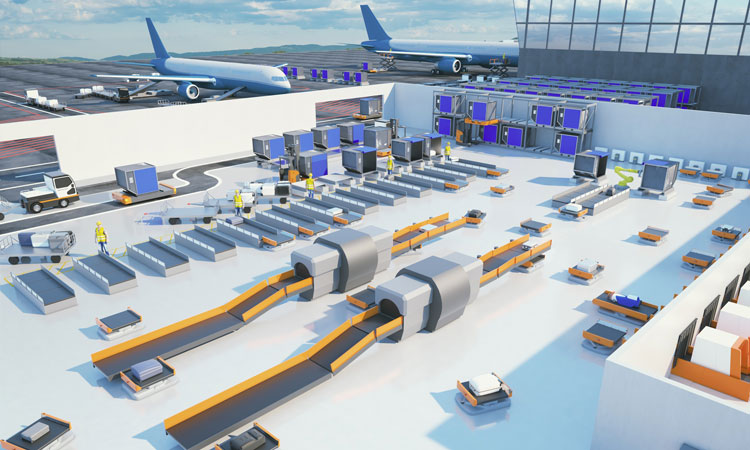Technology and innovation: Indispensable for the airport of the future
- Like
- Digg
- Del
- Tumblr
- VKontakte
- Buffer
- Love This
- Odnoklassniki
- Meneame
- Blogger
- Amazon
- Yahoo Mail
- Gmail
- AOL
- Newsvine
- HackerNews
- Evernote
- MySpace
- Mail.ru
- Viadeo
- Line
- Comments
- Yummly
- SMS
- Viber
- Telegram
- Subscribe
- Skype
- Facebook Messenger
- Kakao
- LiveJournal
- Yammer
- Edgar
- Fintel
- Mix
- Instapaper
- Copy Link
Posted: 25 May 2021 | Mirjam van den Bogaard | 1 comment
It is a quiet time at Eindhoven Airport due to the ongoing COVID-19 pandemic, with significantly fewer passengers and suitcases. But those who think that little is happening are mistaken. The airport is looking beyond the crisis, sticking to its strategy, and working hard with its partners on new innovations and technological solutions for their baggage handling operations.


The Dutch airport in the heart of the Brainport region – a region distinguished by its expertise in technology, design and knowledge – is not about quantity, but about quality. That is why Eindhoven Airport (EIN) is committed to the continuous improvement of the quality of the airport.
“There will come a time when people will get back on their feet,” said Mirjam van den Bogaard, Chief Operating Officer (COO) of Eindhoven Airport. “We are ready for this, with an airport that continuously applies smart technology and continues to innovate to make the journey of passengers and the stay of visitors and employees at Eindhoven Airport even more comfortable.”
The airport as a testing ground
According to Mirjam, innovation is the key to an increasingly sustainable and better airport. Eindhoven Airport is working together with its various partners to make its operations even more efficient, sustainable and customer friendly. “As an airport, we have various roles. One important role is that of an inspirational testing ground. An airport is a unique testing ground because you can test in a controlled environment. We like to invite companies to test their innovations and technological solutions with us, and we have found that more and more companies are interested in doing so,” said Mirjam.
For example, Vanderlande and BagsID are conducting a bag recognition pilot trial at the airport, in which artificial intelligence (AI) is being used. A camera located in the baggage system photographs the suitcase and compares this photo with the photo of the suitcase that was previously uploaded into the system. In this way, the suitcase can be better monitored throughout the baggage handling process. According to Mirjam, this offers advantages for loading and unloading aircraft even more efficiently, but also for better streamlining of airport processes. “In the future, passengers will know whether their suitcase is already loaded. It would be nice if this technology could be developed further, to the point where passengers receive a signal on their mobile phone when their suitcase is on the baggage belt,” added Mirjam, who is following the pilot with great interest. “The first results of the pilot show that AI can be applied in the baggage process. There is the potential for this technology to be used everywhere in aviation in the future.”
Using autonomous vehicles
The collaborative work between Vanderlande and Eindhoven continues in another innovation led trial, where autonomous vehicles on the apron will transport luggage to and from the airport.
Previously, Vanderlande conducted live tests with this technology at Rotterdam The Hague Airport (RTM), gaining insights which further contributed to the development of this solution. RTM will again be the testing ground, as will Eindhoven Airport, where the autonomous vehicle trial will begin in April 2021.
“Our future strategy is based on the belief that innovations in aviation can be implemented faster if different disciplines work together seamlessly”
Mirjam asserted: “Because no driver is needed for transportation, employees can focus on the baggage process itself. Perhaps the process of loading and unloading the aircraft will become more efficient and faster, because individual vehicles will be carrying baggage continuously. Thus, there is no need to wait until the train of baggage carts is fully loaded as there is today.”
Increasing flexibility in the loading and unloading process is a key reason for conducting the trial. “Managing passengers waiting in the arrivals hall for their suitcase is a real puzzle. While it will certainly be some time before we can deploy this new technology, we believe that this new method, the use of data and the deployment of experienced staff will produce an even better baggage process,” Mirjam added.
Self-service technologies improving passenger flows
Technology is also used to improve passenger flow. For example, passengers at Eindhoven will soon be able to print their own baggage labels at bag tag kiosks. Kiosks produced by Flight Solutions are currently being tested. For the time being, baggage labels are still being used in the baggage process. “The use of these kiosks should result in an even faster passenger flow at Drop & Go, because the suitcase is already provided with a self-adhesive label,” detailed Mirjam. “This type of label is easier for passengers to use and prevents ‘unrecognisable’ luggage.”
Mirjam is enthusiastic about the use of technology and conducting pilots at the airport together with airport partners. “Aviation is facing numerous challenges. By innovating, we turn these challenges into opportunities.” Additionally, working with Vanderlande is a logical choice for the COO: “We have been working with Vanderlande, the manufacturer of our baggage systems, for many years. Like us, this company strives to use new technologies to improve the airport process even further. Our future strategy is based on the belief that innovations in aviation can be implemented faster if different disciplines work together seamlessly.”
Innovation as the key to sustainability
Eindhoven is part of the Royal Schiphol Group, which believes that innovation and technology is the key to the most sustainable and best airports in the world. Amsterdam Airport Schiphol (AMS) and the other airports within the Group work closely with each other, as well as with external partners, airlines, universities, start-ups, companies and knowledge institutes, in order to validate new developments for the multimedia hubs of the future. Because Eindhoven Airport and the other regional airports of the Schiphol Group act as testing grounds for technology and innovation, the knowledge gained from these tests are shared within the Group and then scaled up.
“The trick is that the use of technology remains at the service of the passenger and the employee, and should never become a barrier”
According to Mirjam, qualitative recovery after COVID-19 is now more important than ever. Technology and innovation help the airport to make efficient use of assets. In many cases, this is also more sustainable. In addition, it is essential to prevent errors and delays to avoid unnecessary costs. The use of technology in aviation becoming increasingly important is crystal clear, according to Mirjam. Aviation started with technology and the drive to achieve the impossible: “The trick is that the use of technology remains at the service of the passenger and the employee, and should never become a barrier. In addition, it helps us to make possible what seems impossible to some: the development of sustainable aviation,” she concluded.


Issue
Related topics
Autonomous Technology, Baggage handling, Passenger experience and seamless travel, Passenger volumes, Self-service
Related airports
Amsterdam Airport Schiphol (AMS), Eindhoven Airport (EIN), Rotterdam The Hague Airport (RTM)



















You should investigate the use of MBSE (System Engineering) methods and solution to improve your airport operation including baggage system